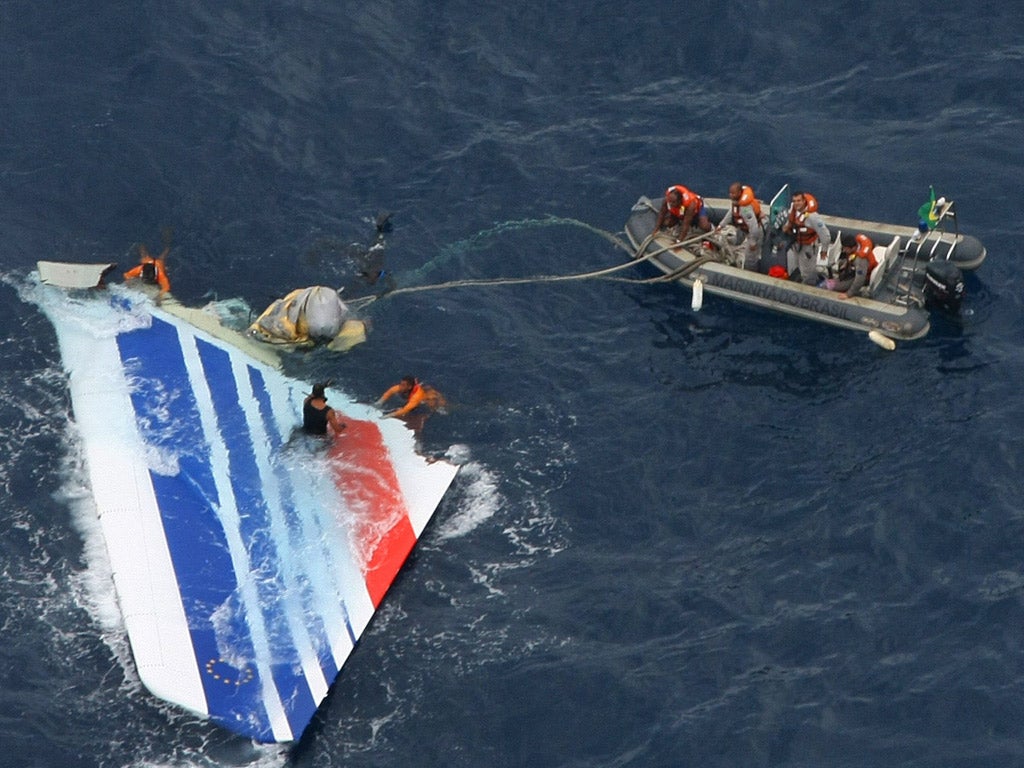Final verdict on Air France 447: sensors left pilots helpless
Official report paints picture of panic in the cockpit as computer errors sparked crisis

The Rio-to-Paris Air France flight that disappeared over the Atlantic in 2009 with the loss of all 228 people on board was brought down not solely by pilot error, but by the failure of the flight director – the instrument on which all pilots depend, the official report on the disaster revealed yesterday.
The mysterious airline crash was so inexplicable that it was days before Air France could bring itself to acknowledge what had happened. The airplane was a state-of-the-art Airbus 330 and the three-man crew had thousands of hours of flying time behind them. But when the plane flew into a thunderstorm, which froze the crucial speed sensors, known as pitot tubes, things began to go wrong in a hurry.
A massive mid-Atlantic thunderstorm was breaking. But the crew – with Captain Marc Dubois, a veteran with more than 11,000 hours of flying time, in charge – chose to fly straight through the storm rather than go around it like other planes flying the same route.
Aware of the turbulence ahead, the co-pilot Pierre-Cédric Bonin warned the flight attendants to illuminate the seat-belt signs. At this point the mood inside the plane was perfectly calm, as the conversation captured by the flight recorder makes clear.
"I'll call the other [attendants] at the back and tell them," an attendant called Marilyn said.
"I'll let you know when we're out of it," Mr Bonin replied. But Flight 447 had only eight minutes left to fly before everyone on board would be dead.
Outside, the pitot tubes that give pilots vital information about the plane's speed had frozen – a problem that had occurred with previous Airbus flights but the company had yet to address. The result was that pilots, with no experience of manual flying at high altitudes, were flying blind.
The recovery of the black box flight recorder from the ocean floor, 22 months after the crash, revealed that the co-pilot, who was flying the plane at the time, bizarrely pushed the nose of the plane upward when it was stalling, making the problem worse.
In a stall, all pilots know that the correct procedure is to lower the nose until the aircraft picks up sufficient speed to fly normally again, but the co-pilot continued to push the Airbus upwards to the point that it was practically motionless.
"I don't have control of the plane," he said. "I don't have control of the plane at all!"
The reason he persisted in pushing the plane upwards, the report revealed, was that the all-important flight director – the computer that issues orders to the pilots throughout the flight – was broken and was giving him the wrong instructions.
And the plane's altitude alarm, the loudest alarm in the cockpit, was quite erroneously warning him that the plane was losing altitude – information that clashed with the warning that the plane was about to stall.
According to Roger Rapoport, an American aviation expert and author of The Rio/Paris Crash: Air France 447, the altitude could have been so loud that the pilots may not have even been aware of the stall alarm. The French investigations agency responsible for the report, BEA, makes 25 recommendations to ensure that a disaster of this type never happens again.
At the heart of the measures is a profound rethink about the extent to which modern airline pilots depend on their computers, leaving them literally helpless in a crisis like this.
"Modern pilots are not trained for crises like this," Mr Rapoport said.
"They are not trained to fly at high altitude. An experienced military pilot might have known what to do in a situation like this, but not these pilots."
The final moments: How the jet crashed
10.29 (GMT) Air France Flight 447 departs from Rio de Janeiro in Brazil for Paris.
2.10am (local time) Pitot tubes freeze, auto-pilot disconnects and co-pilot Pierre-Cédric Bonin is flying the aircraft. He takes the fatal decision to pull up the nose of the jet. It climbs rapidly, causing it to stall. He receives the first stall warning.
2.11am The aircraft stalls and begins falling at a reported rate of 10,000ft per minute.
2.12am Bonin, in a panic, asks if the plane is going up or down.
2.14am An automated voice calls for the pilot to pull up. Seconds later, the plane hits the water.
Join our commenting forum
Join thought-provoking conversations, follow other Independent readers and see their replies
Comments